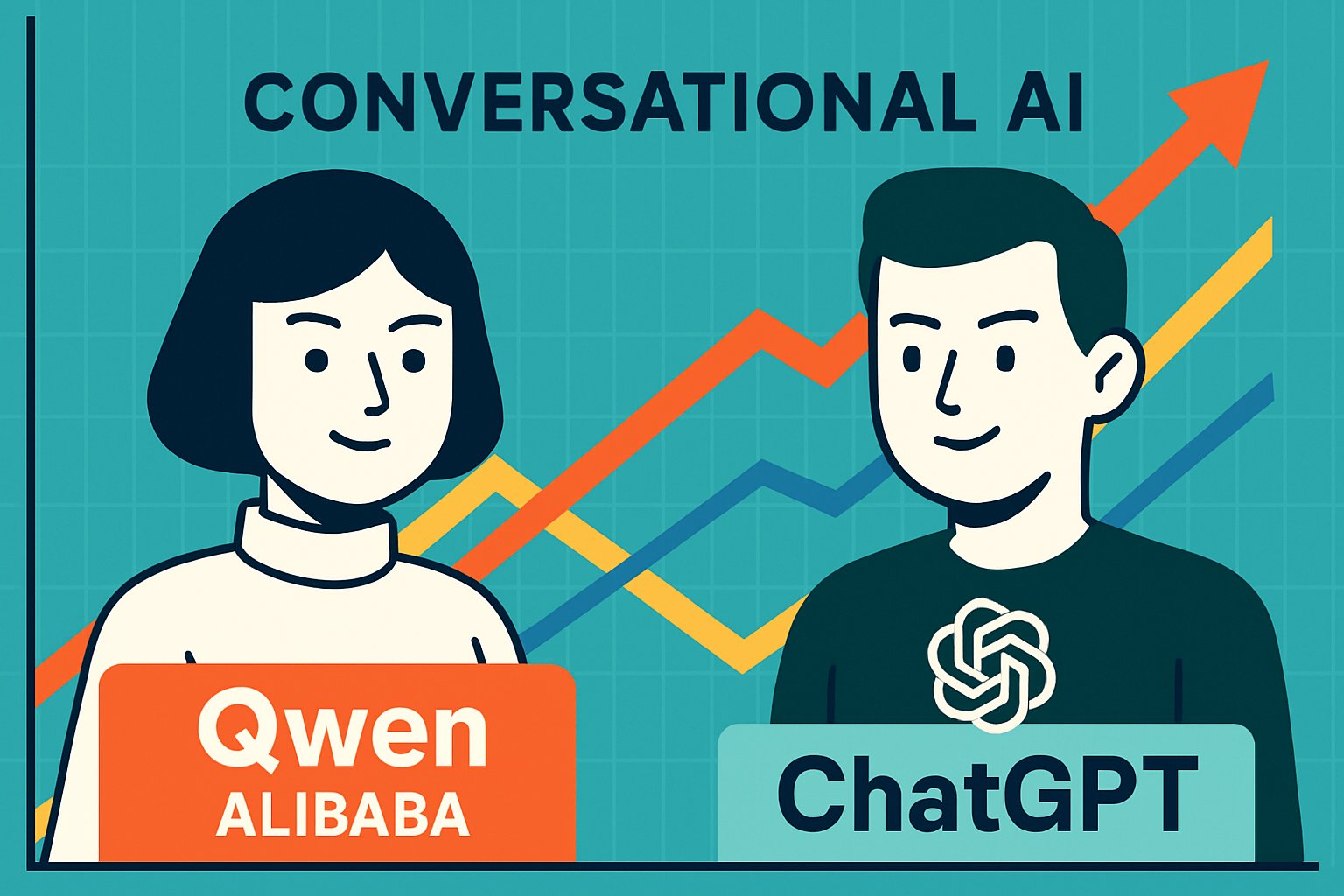
AI CERTs
13 hours ago
Alibaba’s Qwen Ups the Conversational Intelligence Market Race
Alibaba has fired a fresh competitive salvo in the Conversational Intelligence Market. Bloomberg reports reveal the company will rename its consumer Tongyi apps to Qwen and embed agentic shopping flows. Consequently, Alibaba signals a direct attempt to challenge ChatGPT and dominate next-generation digital assistants. The move also highlights growing stakes across Asia’s fast-moving consumer AI arena.
Rebrand Signals Bold Intent
Alibaba will unify model and product branding by replacing Tongyi Chat with the Qwen identity on iOS and Android. Moreover, more than 100 engineers are refactoring the interface to support multimodal context, tool calls, and Taobao transactions. Bloomberg sources say the assistant will stay free, yet premium shopping plugins may appear after user growth stabilizes.

Alibaba’s rebrand merges technical identity and consumer reach. However, market size determines whether the bet pays.
Conversational Intelligence Market Trajectory
The Conversational Intelligence Market was valued between 19 and 25 billion dollars in 2025, depending on scope definitions. Future Market Insights projects expansion to roughly 55.7 billion by 2035, implying an 8.2 percent CAGR. In contrast, MarketResearchFuture forecasts mid-teen growth rates when speech analytics and meeting tools are included. Nevertheless, all studies confirm sustained demand for generative dialogue models powering revenue intelligence and workflow automation. Consequently, venture funding continues flowing into conversational AI innovation for contact centers, sales enablement, and e-commerce.
- Future Market Insights: 25.3 billion value in 2025; 55.7 billion expected by 2035.
- MarketResearchFuture: mid-teen CAGR when analytics and platforms combined.
- Grand View Research: some niches exceed 20 percent annual growth.
The Conversational Intelligence Market grows regardless of definition differences. Therefore, technical capability becomes the next battlefield.
Technical Edge Of Qwen
Alibaba touts Qwen3 models ranging from 1.8 billion to 235 billion parameters, including mixture-of-experts variants. Moreover, hybrid reasoning modes let the model switch between fast extraction and deeper chain-of-thought generation. Alibaba claims benchmark improvements over GPT-3.5 in multilingual tasks, though independent tests remain limited. Generative dialogue models inside Qwen also expose function-calling interfaces that execute real Taobao shopping actions. Additionally, the open-weight release encourages academic replication and accelerates conversational AI innovation across global developer communities.
Generative Dialogue Model Advances
Qwen supports retrieval-augmented generation, multimodal inputs, and memory persistence for longer tasks. Meanwhile, agentic orchestration allows the assistant to call APIs, place orders, and summarize transactions. These capabilities close the gap with ChatGPT while exploiting Alibaba’s commerce data moat.
Technical depth positions Alibaba within the Conversational Intelligence Market leadership tier. Nevertheless, external rivals remain formidable.
Competitive Landscape And Risks
Alibaba faces ByteDance’s Doubao, Tencent’s Yuanbao, Baidu’s ERNIE, and, globally, ChatGPT. Moreover, U.S. export controls limit access to latest Nvidia GPUs, potentially slowing domestic model scaling. Financial Times reports customs crackdowns on chip smuggling, increasing supply uncertainty for Chinese hyperscalers. Regulatory scrutiny also tightens around safety, privacy, and deepfakes produced by generative dialogue models.
Regulatory And Supply Constraints
China’s interim generative AI rules require content labeling and source disclosure, adding compliance overhead. Consequently, Alibaba must deploy robust moderation layers before global expansion. In contrast, OpenAI leverages Microsoft’s steady compute pipeline, giving it capacity advantages.
Competitive forces reshape the Conversational Intelligence Market daily. Therefore, enterprise adoption strategy matters.
Enterprise Adoption Implications Ahead
Enterprise buyers evaluate assistants on accuracy, latency, and governance rather than brand flair. Furthermore, contact-center leaders want unified dashboards that convert conversation insight into coaching actions. Enterprises watching the Conversational Intelligence Market demand transparent metrics and verifiable security. Alibaba’s Qwen, with Taobao transaction hooks, may tap commerce clients seeking revenue-driven conversational AI innovation. However, open-weight licensing also enables third-party hosting, lowering vendor lock-in concerns.
- Contact center analytics budgets exceed 4 billion dollars annually.
- E-commerce chatbots improve conversion by up to 15 percent, according to Alibaba tests.
- Meeting-intelligence tools show 20 percent productivity boosts in pilot studies.
Certification Upskilling Pathways Explained
Talent shortages complicate large-scale rollout of conversation analytics. Professionals can validate skills via the AI + Telecommunication Certification covering network-aware conversational design. Additionally, vendors increasingly request hands-on RAG proficiency during procurement.
Workforce readiness accelerates ROI velocity. Subsequently, strategic insights crystallize.
Strategic Takeaways For Leaders
First, link model branding and consumer product identity to avoid confusion. Second, embed commerce actions directly inside dialogue to unlock differentiated monetization. Third, pursue open-weight releases that advance the Conversational Intelligence Market and encourage community-driven generative dialogue models. Nevertheless, monitor regulatory shifts and hardware supply to mitigate operational surprises. Finally, invest in employee upskilling and articulate clear guardrail policies for conversational AI innovation.
Effective execution turns technology advantage into revenue. Consequently, Alibaba’s progress deserves close observation.
Alibaba’s Qwen overhaul illustrates how product design, infrastructure, and commerce synergies shape the Conversational Intelligence Market. Moreover, sustained research in generative dialogue models and conversational AI innovation will intensify competitive differentiation. However, regulatory oversight and hardware bottlenecks could slow ambitious release cadences. Nevertheless, regional partnerships and cloud innovation can mitigate many constraints. Enterprises should track open-weight progress, benchmark accuracy, and invest in workforce certifications for operational readiness. Therefore, leaders who align strategy with market momentum stand to capture early revenue advantages. Download our analyst guide and pursue the AI + Telecommunication Certification to thrive in the evolving Conversational Intelligence Market.



